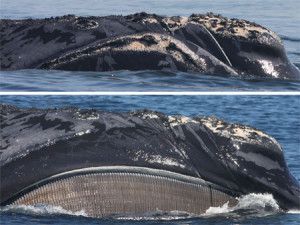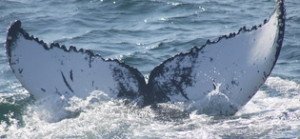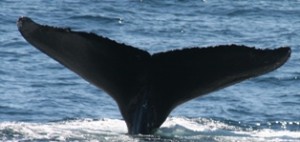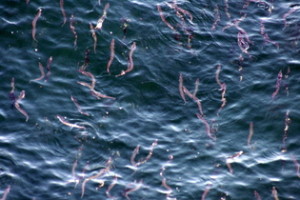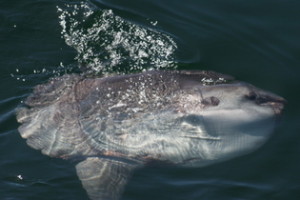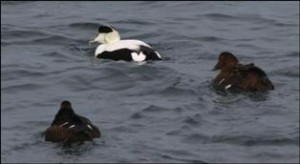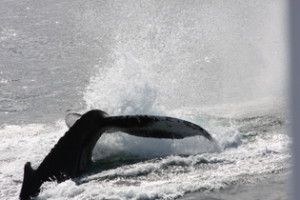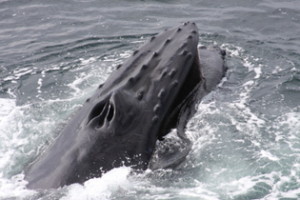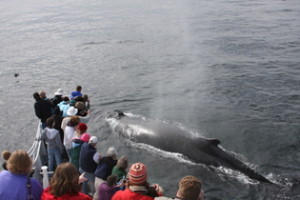Dolphin Fleet Naturalist Notebook – 26 September to 2 October
26 September– Saturday was bright with light southwesterly winds. Leaving the harbor and heading towards Long Point, our captain spotted a whale near the Truro shore. Looking through binoculars the whale was identified as a North Atlantic right whale, a rare sighting this time of year. Numbering less than 390 remaining in the world, it is against federal regulations for a boat to approach closer than 500 yards (457.5 meters). The Dolphin VIII stays a safe distance away so as not to interfere with the movement or behavior of this animal, one of the rarest on earth. Watching the right whale the crew sees signs of a rope or net. Realizing the whale was entangled, the Whale Rescue Team from the Provincetown Center for Coastal Studies was called and the DVIII, U.S. Coast Guard Station Provincetown and the Provincetown Harbormaster stood by the animal until the team arrived.
According to the PCCS, the whale was identified as the 2008 calf of right whale 1321. “Once on scene, the team documented rope wrapping around the head and mouth of the animal forward of the blowholes; potentially impeding its ability to feed. The team acted quickly, removing the entanglement and freeing the whale. “This animal would not have been disentangled without the assistance of the Provincetown maritime community,” said Scott Landry, Director of the Marine Animal Entanglement Response Program.
Gear is strung through the baleen of the endangered North Atlantic right whale
These photos show the head of the whale before and after disentanglement. PCCS image taken under NOAA permit 932-1905, with authority of the ESA.
At most, 10 percent of entangled right whales are reported to authorities each year. Since January, the PCCS team has disentangled two right whales, three humpback whales and eight leatherbacks sea turtles; all listed as federally endangered species. The majority of right whale deaths are the result of human activities including collisions with ships and entanglements in commercial fishing gear… All disentanglement activities are conducted under a federal permit authorized by NOAA.” PCCS requests that if you spot an entangled whale, to please call the Marine Animal Entanglement Response Hotline at 1-800-900-3662.
We continued on to Stellwagen Bank where we spotted humpback and Minke whales moving about the area. We also saw one ocean sunfish. Salt was traveling with Cardhu and Pixar was spending little time on the surface. During the afternoon and sunset trips we traveled to the triangle where there were several humpback and a few Minke whales. Salt and Cardhu had moved west and were logging. Logging is believed to be a resting behavior. Three mother calf pairs were identified: the new, unknown pair and Apex and Bolide and calves. No surface feeding was observed, the whales instead were diving for several minutes and surfacing energetically- with loud, resounding blows. Other humpbacks identified included Epee, Canopy, Draco, Cajun, Eruption, Belly, Ravine, Circuit and Pele. Other species sighted: Ocean sunfish, harbor and gray seals.
The right whale to kill
Pilgrims on the Mayflower in the early 17th century noted that there were so many it seemed one almost could walk on their backs to cross Cape Cod Bay. Right whales were given their name by whalers as they were the ‘right’ or easy whale to kill. They seemed unafraid, were slow moving, and were therefore easy to approach. Their large bodies- up to 50 feet (15 meters) and weighing 70 tons (63,502 kg)- floated when they died. Their extremely long baleen plates were highly prized and oil rendered from their thick layer of blubber lit the lamps of the western world. Right whales have been hunted since the 1500’s and by the 1750’s right whales were so depleted they were in danger of becoming extinct. Although protected since 1935, their numbers continued to decline, primarily from ship strikes and entanglement in fishing gear.
27 September–Heavy winds- trips cancelled
28 September– Monday was bright with westerly winds. We traveled to the triangle- off the eastern edge of Stellwagen Bank. The humpback whales again were on long dives and the Minke whales surfaced at a distance. Several humpbacks were identified, including: Tear, Soot, Broomball, Jabiru, Buckshot, Circuit, Eruption, Salt, Cardhu, Bolide and calf, unknown mother and calf, Cajun and Pele.
Citation Eruption
Although humpback whales are thought to be more solitary than toothed whales (with the exception of mothers and calves), Citation and Eruption have been traveling together for the past few weeks. Salt and Cardhu also have been traveling and resting together for the past several weeks. These two, mature females have extensive sighting histories and have been sighted together in other years, particularly when they are without calves.
Cardhu
Salt
29 September– Tuesday was bright with southwesterly winds. As we slowly move through the harbor and look to Fishermen’s Wharf on our right, a series of photographs entitled “They Also Faced the Sea” stand out against a weathered wooden backdrop. Mounted on a building at the end of the wharf are 5 large black and white photographs of Provincetown women of Portuguese descent, a tribute to the Portuguese community and its fishing heritage. Photographed by Norma Holt, striking images of Almeda Segura, Eva Silva, Mary Jason, Bea Cabral and Frances Raymond represent the women of Provincetown whose families fished the waters off the Cape for over 200 years. They faced the sea in many ways as they kept their culture alive and were the backbone of this vital fishing village. Looking at the photographs, we also are reminded of the artistic culture of the town, the oldest artist community in the United States.
Our watches today take us back to the triangle with sightings of several humpback whales. As in the past several days, the whales are staying in the same general area and surfacing energetically after their dives. Even the calves spend less time on the surface. It is likely they (at least the adults) are feeding deep in the water column on the American sand lance or sand eel. Sand lance can reach lengths of six inches (15 cm) and can live to be five years old, an amazing feat considering they are feasted on in all stages of their life, from larvae to adult. Sand lance burrow into loose sand, hence their common, descriptive name. In the sand at the bottom of Stellwagen Bank and surrounding areas, they burrow to escape predation, to rest and to hibernate after spawning. Humpbacks sighted include Apex and calf, Bolide and calf, Blackhole and calf, Tunguska, Draco, Rune, Pele, Milkweed, Belly, Eruption and Citiation.
Sand Eels
30 September– Wednesday was overcast with light westerly winds. The whales, several humpbacks and one Minke, are closer to Provincetown today. During the morning, Bolide, canopy, Pele, Milkweed, Belly Cajun, Eruption, Citation, Tracer, Leonid and Ravine spend most of their time on dives. There is little activity except for the occasional chin breaching and lobtailing of Tear and Rune. By afternoon, just south of Stellwagen Bank, the humpbacks begin to surface feed- a spectacular sight. Rune, Tear, Nazka, Pumba, Echo and Tracer are kick feeding, slapping their tails on the surface of the water before diving and blowing rings of bubbles. The whales surface through the bubbles with mouths full, water pouring out through the baleen plates entrapping the small fish within.
As we leave the area we stop to look at one of natures most unlikely and bizarre creatures: the Mola mola or ocean sunfish. The word Mola is derived from Latin- meaning millstone, a fitting descriptor. The body is large, round and flattened with no discernable tail. The mouth, perpetually open, sucks in small animals such as jelly fish that drift by. Lying on its side, the ocean sunfish appears as a swimming head and can weigh as much as 2.5 tons. Despite size and shape, it swims gracefully through the water by synchronous flapping of its two large fins. It is possible that sunfish live to be over 100 years old.
1 October- Thursday was bright and cool with Northwesterly winds. The harbor is filled with Common Eiders today as we leave for our morning whale watch on the Portuguese Princess. Eider ducks spend almost all of their lives on or in the water. They feed primarily during the day, and at low tide, avoiding strong winds and large waves in Provincetown’s protected harbor. They dive well below the surface and use their wings to swim under water feeding on crabs, snails, mussels, clams, starfish, sea urchins and other small marine life. The common eider male’s color pattern is the reverse of most aquatic birds – with black bellies and white backs. The females are mottled brown, well camouflaged against their seaweed nesting habitat.
Our watches today take us to the southeast corner of Stellwagen Bank where we sight humpback whales and a Minke. The whales are not as numerous as they were yesterday, but that is no surprise as they move continuously from one area of the region to another in search of food. Division and Cajun, both mature females were flipper slapping and breaching while Buckshot, also a female, was diving deep. By afternoon, more humpbacks including Citation, Eruption, Orbit, Canopy, Tunguska, Circuit, Habenero, Blackhole and calf, Anchor and calf, Draco and Echo had moved into the area. The whales again were diving for 6 to 10 minutes however Anchor’s calf stayed near the DVIII while its mom was below.
2 October– Friday was bright with light Northwesterly winds. Today the whales were on the southern end of Stellwagen Bank. Most of the sightings were of humpbacks, with only 2 Minke whales and two ocean sunfish. In the morning Belly was traveling with Citation and Eruption and follicle and calf were traveling slowly to the North. Tear and Rune, still traveling together were breaching and flippering-an impressive sight as both are mature whales. Pele, Aerospace, Canopy and Mostaza also were in the area and diving and surfacing together. Ventisca was traveling alone. By afternoon the whales were surface feeding. Buzzard, Broomball, Pixar, Release, Buckshot and Nazka were kick feeding- each with their own style- and surfacing through clouds and nets of bubbles. Blackhole also was kickfeeding and on occasion, her calf would surface with a mouth full. This time of the year the calves are beginning to supplement mother’s milk with a feast of small fish. Thumper, Ganesh and Glo and calf were traveling through the area- Thumper stopping occasionally to feed. Shearwaters, gulls and terns surrounded the whales each vying for sand eels. All in all, it was an exceptional day of whale watching!






